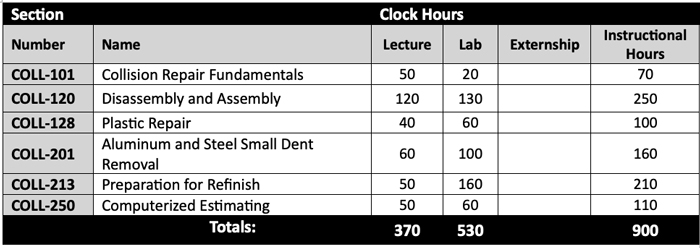Collision Repair Technology
9 Months – Total Clock Hours: 900
Starts: 8/26/2026
2026 2027 Tuitions Fees: $9,666
Admission Requirements
Application Fee, Application, Enrollment Agreement, High School Diploma, Transcript or GED, Criminal Record Check, Child Abuse Clearance, and FBI Fingerprinting.
Program Overview
The Collision Repair Program at Central PA Institute of Science and Technology (CPI) provides students with hands-on skills and technical knowledge needed for a successful career in the automotive collision repair industry. This 900-hour, 9-month program covers all aspects of collision repair, including non-structural and structural repairs, refinishing, welding, estimating, and shop management. Students will learn to assess vehicle damage, perform repairs using industry-standard tools and equipment, and apply refinishing techniques to restore vehicles to pre-accident condition.
Emphasizing both technical expertise and career readiness, the program includes I-CAR Certification Training, ensuring students meet industry safety and technical standards. Students will also gain experience with estimating software, insurance procedures, and customer service skills to prepare them for real-world collision repair environments. Graduates will be equipped for a variety of career opportunities, including positions as auto body technicians, refinishers, estimators, or shop managers. The program consists of 370 lecture hours and 530 lab hours, blending classroom instruction with hands-on application in a professional learning environment.
Courses In This Program Include:

Course Descriptions
COLL 101: Collision Repair Fundamentals
In Collision Repair Fundamentals, students will learn the foundational skills necessary for working in the collision repair industry. This course covers shop safety, tool identification, personal protective equipment (PPE), and OSHA regulations. Students will be introduced to the basics of vehicle construction, measuring techniques, and minor bodywork. Hands-on training includes surface preparation and small panel repairs. (50 lecture hours, 20 lab hours)
COLL-120: Disassembly and Assembly
In Disassembly and Assembly, students will develop skills in safely removing and reinstalling vehicle components, including bumpers, trim, lighting, and interior panels. The course covers proper documentation, fastener identification, and part alignment techniques. Hands-on training will focus on preserving undamaged components, ensuring proper fit, and reassembling vehicles to pre-repair condition. (120 lecture hours, 130 lab hours)
COLL-128: Plastic Repair
In Plastic Repair, students will learn industry-approved techniques for repairing automotive plastics, including bumper covers, grilles, and interior panels. The course covers plastic identification, adhesive bonding, welding methods, and refinishing procedures. Students will complete hands-on repairs using plastic welding and chemical bonding techniques to restore parts to OEM specifications. (40 lecture hours, 60 lab hours)
COLL-201: Aluminum and Steel Small Dent Removal
In Aluminum and Steel Small Dent Removal, students will develop skills in repairing minor dents and damage on both steel and aluminum vehicle panels. This course covers metal characteristics, proper tool selection, and repair techniques such as paintless dent removal (PDR) and traditional dent pulling. Hands-on training will focus on restoring panels with minimal filler use while maintaining structural integrity. (60 lecture hours, 100 lab hours)
COLL-213: Preparation for Refinish
In Preparation for Refinish, students will learn the critical steps involved in preparing a vehicle for painting and refinishing. This course covers surface cleaning, sanding techniques, masking procedures, primer application, and defect prevention. Hands-on training includes proper spray gun setup, sealer application, and panel blending techniques to ensure a high-quality finish. (50 lecture hours, 160 lab hours)
COLL-250: Computerized Estimating
In the Computerized Estimating course, students will develop the knowledge and skills necessary to create accurate and professional collision repair estimates using industry-standard computerized estimating software. Students will learn to assess vehicle damage, interpret repair procedures, and generate detailed estimates that align with insurance and repair facility requirements. Through hands-on training, students will gain proficiency in identifying and documenting vehicle damage, navigating computerized estimating software, understanding labor times, parts pricing, and repair methodologies, writing comprehensive estimates for insurance claims and customer repairs, and communicating effectively with customers, insurance adjusters, and repair technicians. (50 lecture hours, 60 lab hours)
Harbor Freight or Similar
9-Drawer Storage Cabinet (SKU 56613)
6in Orbital Air Sander McGraw (SKU 58400)
3-inch Air Cut-off Tool MCGR (SKU 58690)
1/4-inch Air Angle Die Grinder (SKU 58909)
1/2-inch Composite Air Impact (SKU 58912)
301 PC Pro Mechanics Tool Set (SKU 63464)
Inline Air Sander BXTR (SKU 63994)
1/2-inch Belt Air Sander BXT (SKU 64932)
1/4-inch Air Die Grinder (SKU 70733)
450L Rechargeable Pen Light (SKU 70806)
20V 2-tool Combo Kit (SKU 71291)
1 YR ITC membership (SKU 403)
High Flow Air Blow Gun (SKU 63572)
Dual Chuck Inflator With Dial (SKU 63544)
21 pc Drill Bit Set HA23-2 (SKU 63384)
Socket Rail Tray SAE Red (SKU 70025)
Socket Rail Tray MM Black (SKU 70024)
*note the replacement plan is not required but it is suggested in case you need replacement within 2 years.
